Amazing Colors for the Fall Months
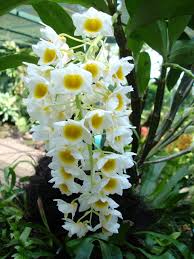
The fall months are depicted as a time when plants are preparing to take their long-awaited winter nap as leaves (deciduous plants) begin to fall from the trees along with the slow growth of garden plants. And while this is true for many plants there are so many that continue to grow (every green plant) throughout the year. Deciduous plants lose their leaves at a certain time of the year but will produce fresh beautiful leaves when the growing season or warmer months returns. Evergreen plants are plants that retain their leaves throughout the year and into the following growing season. However, in our discussion, we will be turning our attention to orchids.
Installing orchids in your indoor living space during the fall months is a great way to not only connect with nature indoors but to really brighten and liven up things Over the years I have worked with many species of orchids on so many garden projects creating many beautiful shows that were just simply amazing. There is said to be about 47 orchid species that bring their very own uniqueness with their many leaf shape, flower designs, sizes, and colors.
While we cannot discuss all 47 of them which is beyond the scope of this article we will be taking a closer look at at least 5 of them so you can know how to care for them during the fall months. So with that said we begin our discussion on orchids to plant in the fall in South Florida.
1. Phalenopsis Orchids
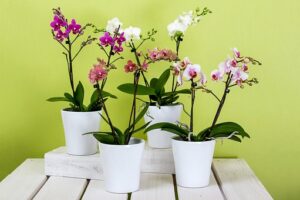
Phalenopsis orchids are native to the tropical regions of Australia and Asia, this perennial herbaceous plant thrives best in USDA Hardiness Zones 10 to 12. Phalaenopsis orchids require good lighting, however, direct lighting will scorch the leaves, if insufficient lighting is an issue then consider installing artificial or grow lights. A 40 0r 70 fluorescent tube can work, once the light or lights are installed place the orchid 12 inches underneath the light. Rotate phalaenopsis from time to time to keep the growth even. During the colder months place your phalaenopsis in a south-facing or east-facing window to get some direct sunlight. Insufficient lighting will result in dark green leaves while too much lighting will encourage a reddish or pink tinge to form along the leaf margins that will turn yellow in time.
During the growing season water your phalaenopsis weekly or whenever its exposed roots turn silvery white, water your phalaenopsis once a week. Pour room-temperature water slowly over the bark. Repeat this action 3 0r 4 times to ensure the orchid gets adequate water. Once the orchid pot is completely drained return the plant to its position, always water orchids from the roots because if the leaves get wet and that moisture is allowed to remain will encourage rot.
Root and stem rot occur when the growing medium has been overwatered and is saturated, during the growing season which is the summer months apply a diluted orchid fertilizer every third or fourth week. During the spring fall and winter months avoid fertilizer application which will encourage leaf growth and no bloom.
The temperature and the humidity level play an important part in the health of your orchid, the inside temperature can be anywhere from 65 to 85 degrees Fahrenheit. A fan or humidifier will help to keep the inside atmosphere comfortable. Mature orchids can be pruned once a year during the dormancy period after the blooms have faded. Snip back unhealthy roots, that are brown, mushy, or dead, and remove spent flowers with the help of a clean sharp knife or scissors. Cut the top portion of the stem back to 1- inch above a node to encourage a new stem section and more blooms.
2. Dendrobium Orchids
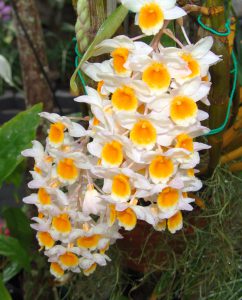
Dendrobium orchids are native to tropical and subtropical Asia, Australia, and many Pacific islands, dendrobiums are epiphytes meaning they can grow on other plants. In nature, dendrobiums can be seen growing on other plants, the USDA Hardiness Zones for these orchids are 9 to 12, and there are said to be almost 2000 species of this plant type, water your dendrobium with tepid rainwater in the summer just enough to ensure that the potting mix dose, not dry out.
Once watering is done make sure that the remaining water is drained from the drip try to ensure that the roots are not exposed to standing water, during the growing season mist on a regular basis, and feed every third watering with orchid fertilizer. A daytime temperature between 16-21°C (61-70°F) during summer time with a 5°C (10°F) difference will keep your dendrobium in good shape.
During the winter months locate your orchid in an area that’s warm, and bright with cool temperatures between 10-13°C (50-55°F), ensure during the winter months that your dendrobium is exposed to direct light. Once the flowers start to appear place orchids back in their original place once cold months have passed.
Dendrobiums prefer a humidity level between 50 and 70 percent, if the tips of these orchids turn brown may be a sign that the air is too dry a spinning fan or humidifier will offer some help.
3. Cattleya Orchids
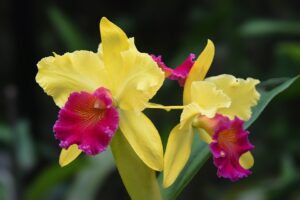
Here is a beauty that is about to rock your world, the cattleya orchid produces large flowers that are fragrant with various colors, this plant belongs to a species of 46 and is native to Costa Rica south to Argentina and thrives best in USDA Hardiness Zones 10 to 11, the flowers of this orchid is showy. These plants are epiphytic which means they naturally attach themselves to other plant species.
Avoid placing cattleya in direct sunlight that will encourage plant burn, it is good to note also that if this orchid has dark green leaves is an indication that it is not going to flower. But if the leaves are light green is a sure sign that your cattleya will flower.
If the leaves turn a red-tinged is a sign of too much sun, the ideal spot to place this orchid type is near an east-facing window or a west or south-facing window that has a sheer.
The ideal temperature for cattleya is 60-64° F at night with daytime temperatures of 70-80° F, moderate to high humidity is comfortable for this orchid which can be anywhere from 50-80%. Fertilize your cattleya with an orchid fertilizer, before applying read and follow the manufacturer’s directions for the best results. When giving your cattleya water use room temperature or lukewarm water.
Avoid the use of softened water that will cause damage, once done with watering make sure to drain the water from the tray because if the roots are allowed to remain will lead to root rot. Allow the potting medium to dry out between watering. Applying water once a week is sufficient, after a week if the potting medium is still damp wait about a day or two then add water or give the orchid a good soaking.
In Case you missed it here are other articles on orchid plants, repotting orchid plants, orchids and their place in the landscapes, orchid care during the winter, and ice cubes to water orchids.
4. Epidendrum Orchids
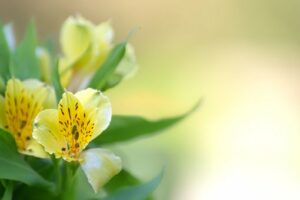
The epidendrum orchid is native to southeastern North America to central South America and is primary epiphytic although some grow from the soil and on rocks. There are said to be more than 1,500 species. The USDA Hardiness Zones for the epidendrum orchid in zones 10 to 11, when installing this orchid indoors ensure that it gets bright indirect light by placing the plant near an east-facing window or west or south-facing window, use sheers if needed to help to protect the plant from sunburn.
A good orchid potting or cactus mix is ideal for water absorption and proper drainage, epidendrum needs regular watering but allow the roots to dry out between watering. During the warmer weather, they may need to be watered once or twice a week sometimes they may need a third watering depending on heat conditions. In cooler weather water once or twice every 2 weeks.
Fertilize your epidendrum with a high-quality orchid fertilizer that’s diluted once a week or every 14 days. Different species of epidendrum orchids’ temperature requirements are different. These orchids, however, are pretty tough although they cannot handle freezing conditions they can thrive in a range of temperatures. During the day hours, they prefer temperatures around the low 70s and nothing below 10 degrees Fahrenheit at night. A comfortable humidity level can range between 50 and 70%.
5. Vandas Orchids
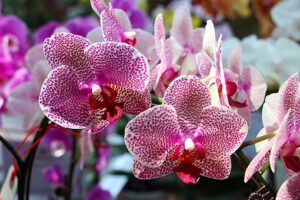
Vandas are so beautiful with their colorful showy flowers, this orchid species is native to the tropical and subtropical regions of the Pacific and Asia, in its natural habitat vandas can be seen growing from rocky locations, or hanging from cracks in the cliffs and from trees. Vandas orchids thrive best in USDA Hardiness Zones 10 to 11. Although its natural habitat is outdoors it can be grown indoors as well.
When growing vandas indoors locate an area that gets bright indirect sunlight light like a south or west-facing window, if you don’t have sufficient lighting then artificial fluorescent (grow lights) light will do. This orchid needs lots of moisture so ensure that the bark medium is moist, in other words, water orchids thoroughly however don’t overwater which can lead to root rot.
Allow the medium to dry out somewhat before adding more water, avoid the use of tap water that may contain chlorine and fluoride, instead use distilled water or rainwater. Ensure that the water is room temperature.
Fertilize every 2 weeks in the summer with an orchid fertilizer, the ideal temperature during the daytime hours can be 70-85°F/21-29°C once the temperature drops to at least 15° at night will trigger flower buds. Moderate to high humidity is good but preferably 50-80%, to help make indoor humidity more comfortable consider installing a humidifier or a humidity tray.
The final word on orchids to plant in the fall in South Florida
Orchids are amazing plants and have shown they can put on a show with their amazing colorful flower bloom, orchids have their place in the landscapes and gardens including indoors. I encourage you if you have not as yet install some of these amazing beauties that will brighten your days as you connect with nature. You will be so happy with the results as you reap the benefits.
About the author
Norman loves being in the garden, both at home and for his job....
he is 'Natures Little helper' being outdoors, growing his vegetables and flowers from an early age.
Now having spent over 22 years in the profession he want to give some of his knowledge to others...
his vast array of hints and tips you will find scattered over this site will help you no end growing plants in your garden.
